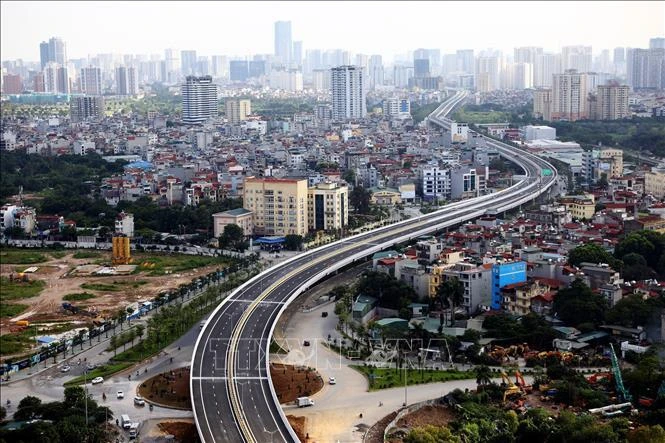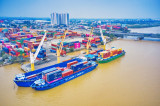Ministry outlines two economic growth scenarios for 2025
The Ministry of Planning and Investment recently presented to the Government three economic growth trajectories for 2025, with the highest rate forecast at 7.5%.

The Ministry of Planning and Investment recently presents to the Government two economic growth trajectories for 2025. (Photo: VNA)
In the first scenario, the country’s gross domestic product (GDP) is predicted at 6.5-7%, and inflation rate at 4-4.5%, given the global situation staying complicated and unpredictable, the global economic growth remaining low, and the global macroeconomic environment facing numerous risks. As a result, the average economic expansion for the 2021-2025 period will be 5.8-6%.
Meanwhile, in the second, the ministry eyes a GDP growth of around 7-7.5%, and inflation rate at 4.5%, which could be achieved if the global situation, economic powers, and major trading partners of Vietnam enjoy better improvements than expected, and industrial production, export and foreign investment attraction on a strong surge. In this scenario, the average GDP growth will be 5.9-6.1%.
The ministry has been in favour of the first one since the domestic economy has been affected by adverse external developments, while several intrinsic problems could not be improved in a short term.
In its recent forecast, the Asian Development Bank (ADB) said the Vietnamese economy will grow 6% this year, and 6.2% in 2025. ADB Country Director for Viet Nam Shantanu Chakraborty held that robust rebound in trade, production, and foreign invest attraction have brought rosy signs to the Vietnamese economy.
The bank also gave a positive prospect for the economy, estimating the GDP to expand 6.1% in 2024, and 6.5% in 2025. It hailed the economy’s resilience capacity amidst increasing challenges across the globe.
With a view to concretising the economic growth target of 6.5-7% this year, and even higher in 2025, the ministry has proposed prioritising growth on the basis of stabilising the macroeconomy, curbing inflation, ensuring major balances, accelerating the disbursement of public investment, attracting foreign investment, and mobilising resources from state-owned corporations.
Besides, it is necessary to restructure the economy in tandem with improving productivity and competitive edge, renewing traditional growth drives, and bolstering digital, green and circular economies, and focus on reviewing and removing bottlenecks, particularly legal procedures, for development, the ministry added.
WB experts said the recovery of manufacturing and processing exports, and that of tourism, consumption and investment are important drivers of the Vietnamese economy’s growth.
The bank’s East Asia and Pacific Practice Manager for Macroeconomics, Trade, and Investment Sebastian Eckardt held that developing the capital market will create long-term funding for the economy, helping Vietnam realise its target of becoming a high-income nation by 2045.
Pushing ahead the disbursement of public capital not only helps stimulate demand in the short term but also deal with infrastructure shortages, especially in energy, transport, and logistics, which are seen as barriers to economic growth, he added.
Meanwhile, Minister of Planning and Investment Nguyen Chi Dung has affirmed that luring investment in pioneering industries like semiconductor and AI is a key that enable Vietnam to catch up with, advance together, and overtake others in the global playground./.
VNA
 Binh Duong signs cooperation and investment agreement with South Korea’s Daewoo E&C
Binh Duong signs cooperation and investment agreement with South Korea’s Daewoo E&C
 Intensive actions of tax revenue to exceed in the year
Intensive actions of tax revenue to exceed in the year
 Businesses focus efforts on new development phase
Businesses focus efforts on new development phase
 High-Quality Human Resource Training Cooperation for Businesses
High-Quality Human Resource Training Cooperation for Businesses
 Visitors enjoy hundreds of images and artifacts at thematic exhibition “People's Armed Forces of Binh Duong province in fighting, building and defending the Fatherland”
Visitors enjoy hundreds of images and artifacts at thematic exhibition “People's Armed Forces of Binh Duong province in fighting, building and defending the Fatherland”
 Multiplying exemplary models of the "Excellent and Creative Labor" Emulation
Multiplying exemplary models of the "Excellent and Creative Labor" Emulation
 Logistics companies take advantage of opportunities to innovate and grow
Logistics companies take advantage of opportunities to innovate and grow
 Counterfeit, smuggled goods on e-commerce platforms: Current situation and solutions
Counterfeit, smuggled goods on e-commerce platforms: Current situation and solutions
 Coordination programs are guaranteed to be practical and effective
Coordination programs are guaranteed to be practical and effective
 ENTERPRISES LISTED IN THE GREEN BOOK: Role models on sustainable environmental protection
ENTERPRISES LISTED IN THE GREEN BOOK: Role models on sustainable environmental protection





